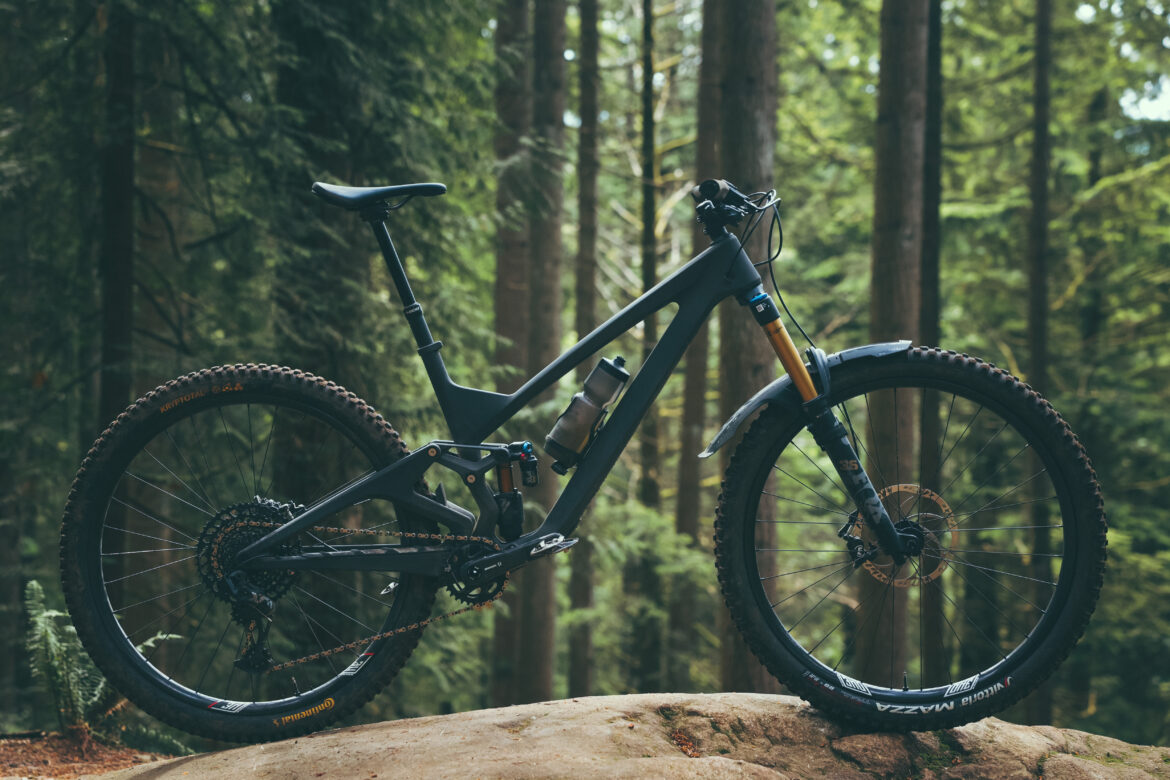
The We Are One Arrival has, uh, arrived. This is the Kamloops-based brand’s first go at a bike frame, and it’s quite the debut. Emerging in mid-2021 to a good deal of anticipation and fanfare, the Arrival is pretty futuristic in terms of both aesthetics and engineering. Now that the hype has died down a little and we’ve had the chance to put some miles on the bike it’s time for us to tell you what we think. To save ourselves repeating some of the details, if you didn’t catch our ‘in for test’ article, have a read here.
The Arrival is We Are One’s approach to the perfect trail bike, with 29er wheels, 160mm travel at the front and 150mm at the back. They designed it to be EWS-ready with a competitive weight and a finely tuned suspension package for an edge on the climbs so that it can be a no-compromise, do-everything bike with an emphasis on descending speed.
Perhaps worth mentioning again is that We Are One intends the Arrival to be something of a ‘forever bike.’ They say that they will back frames up with a lifetime warranty, and in the case that they deem something to not be a manufacturing defect, ie a crash, they will back the bike up with affordable repairs. The frame is hand-laid in Kamloops with all aluminum frame parts machined in-house, and most of the components are sourced from local and North American manufacturers such as North Shore Billet, Industry Nine and Chris King, We Are One. The brand is doing their best to cut down on both waste materials and air miles, and I really respect that.

We Are One Arrival frame details
The Arrival frame is really nicely put together, regardless of whether or not you like the design. Aesthetically the angular design makes it look pretty different from anything else out there, even though the floating pivot suspension layout visually isn’t actually that different compared to a lot of bikes. The devil really is in the details with the Arrival, and We Are One has created a pretty dialed bike. All hardware is either titanium or machined aluminum made in house. Almost all the the bolts are titanium, so you know they’re not going to rust, snap, or round out easily, and all fasteners are flush with the frame, making for a really clean look and reducing the likelihood of getting snagged on the trail.
The frame features internal routing, however it’s not fully guided, presumably as this would add weight and make the layup sub-optimal. That said, the routing is clean, and there’s a big hole near the bottom bracket to fish cables through, so it shouldn’t be too much of a pain to work on, and I never heard any cable rattle inside the down tube. The cable entry and exit ports are nice and clean and there are no finicky rubber grommets to mess around with.


The Arrival does use a few proprietary parts such as the derailleur hanger, which is to be somewhat expected, and the rear brake mount. The rear brake does not use a standard post mount and instead uses its own adapter machined in house, supposedly to make the brake mount stiffer. Currently this is only available for a 180mm rotor, with plans for a 203mm later on. As for frame standards, the wheels are 29/29, the rear hub spacing is Super Boost, the BB is threaded, and the seatpost diameter is 31.6mm
The finish on the Arrival is worth a mention while we’re here. Rather than simply using regular old paint or clear coat on top of the carbon, We Are One opted to use Cerakote, a ceramic-based finish that’s super hard and tough. It gives the bike a matte appearance and they’ve gone for a black to clear fade, which looks cool. The finish itself seems to be super durable and doesn’t seem to get any small scratches like you might find on a more traditional paint finish. My top tube is usually a haze of small scratches from my shorts/knee pads after a few weeks of riding, but I couldn’t see a single mark on the Arrival. Very cool.

We Are One Arrival geometry and sizing
The geometry on the Arrival is decidedly modern. With the head tube angle sitting at 64º, a reach of 500mm, and 441mm chainstays on the size three (SZ3) on test here, it’s slack and it’s long. The seat tube angle is 77º and each size of bike comes with a 45mm stem. This means the bike doesn’t feel excessively long while seated, though it still feels quite long. We Are One says that “the first step was to get that stable ‘in the bike’ feel instead of the ‘on the bike’. Having 75-85mm bottom bracket drop and head angle of around 63 deg, at sag with the rider on, allowed dropping the centre of gravity of the whole bike/rider combo by up to 20mm compared to other enduro bikes in the same class. This removed the need to have excessively long front and rear centre of the bike, which is a common and easy way of increasing overall stability of the bike.”
With only three sizes to choose from, my 6ft height supposedly fits their SZ3 bike, recommended for riders anywhere between 5’11” and 6’4″. I’ll be honest, the SZ3 feels too big for me and while the Arrival definitely achieves the “in the bike” feeling, I’d argue that sometimes I want to feel like I’m ‘on the bike’ these days, mostly because we’ve come a long way from high bottom brackets and long reaches and the longer, lower trend has to stop somewhere. Speaking of lower, I couldn’t get the supplied 200mm dropper low enough in the frame to be able to pedal with the post fully extended, and so had to swap for a 170mm post. While riding there were also a few handling quirks that I put down to the length of the bike, and if I were to buy one of these personally I’d probably size down.
For a more in-depth look at the geometry, check out our ‘in for test’ article here.



Suspension
We Are One decided to go with a floating pivot suspension design, they say because it “gave a bike amazing benefits over choppy terrain and was more active than other designs.” Similar to Maestro, DW-Link, and others, floating pivot designs have proven time and time again that they can work extremely well, as well as being highly tunable. The Arrival has a fairly high leverage ratio as evidenced by its fairly short shock stroke — 55mm for a 150mm travel bike. The Arrival comes stock with a Fox Float X2 Factory to keep things under control with both high and low speed compression and rebound adjustments.
We Are One says their aim was to create a platform around the sag zone at around 22-25% travel to keep the bike riding high and to give it similar ride characteristics to a shorter travel bike in the initial portion of the travel which ‘wakes up’ the bike on lower intensity trails and makes it easier to move around. They go on to say that “both the anti-squat and the anti-rise values are set up to aggressively preserve geometry in that sag ±20mm zone and that the leverage ratio starts high at 3.4 and drops to 2.95 at sag, which allows the Arrival to be extremely supple off the top, even when set up with air shocks. For the remainder of the rear travel — sag to bottom out — the leverage ratio preserves the progressive behavior, but only drops down by another 0.5, down to 2.45, when fully compressed.” This progessivity is backed up by the fact that We Are One offers the Arrival with a Push Elevensix coil shock as an option.
We Are One designer Vlad Yordanov adds, “Anti rise values are pretty constant — 95% at sag, and falling down to 80% at full bottom out, which provides a very consistent and predictable braking feel throughout the whole travel range.”
He goes on to say, “The front to back centre ratio starts out at 1.87, then 1.83 in the sag area, and ends at 1.77 at full bottom out. The rider’s confidence comes with consistent and predictable grip, so having a constant front to back weight distribution throughout the whole travel allows the rider to stay in their desired position, without trying to compensate for any excessive shifts.”

On the trail
The Arrival is a tricky bike to talk about. It’s not quite like any other bike I’ve ridden so it’s taken me a little while to order my thoughts on it, and honestly I could probably spend a little while longer trying to get the setup properly dialed on it. The best way I can think to describe the way the Arrival rides is like a short travel bike disguised as a bigger travel bike.
I feel like the sizing of the Arrival plays a big part in its ride, and for me despite being an inch taller than the recommended height for this SZ3 bike, I couldn’t help but feel that the reach was too long for me. There were a few things I didn’t massively enjoy about the Arrival that I think were size-related, and I’ll be honest their sizing chart is a little strange with a 5″ window for the SZ1, a 3″ window for the SZ2 and a 4″ window for the SZ3. I’m not sure if the folks at We Are One think these sizes are actually appropriate or if they are simply trying to shoehorn more folks into their bikes because they didn’t want to make more than three frame molds.
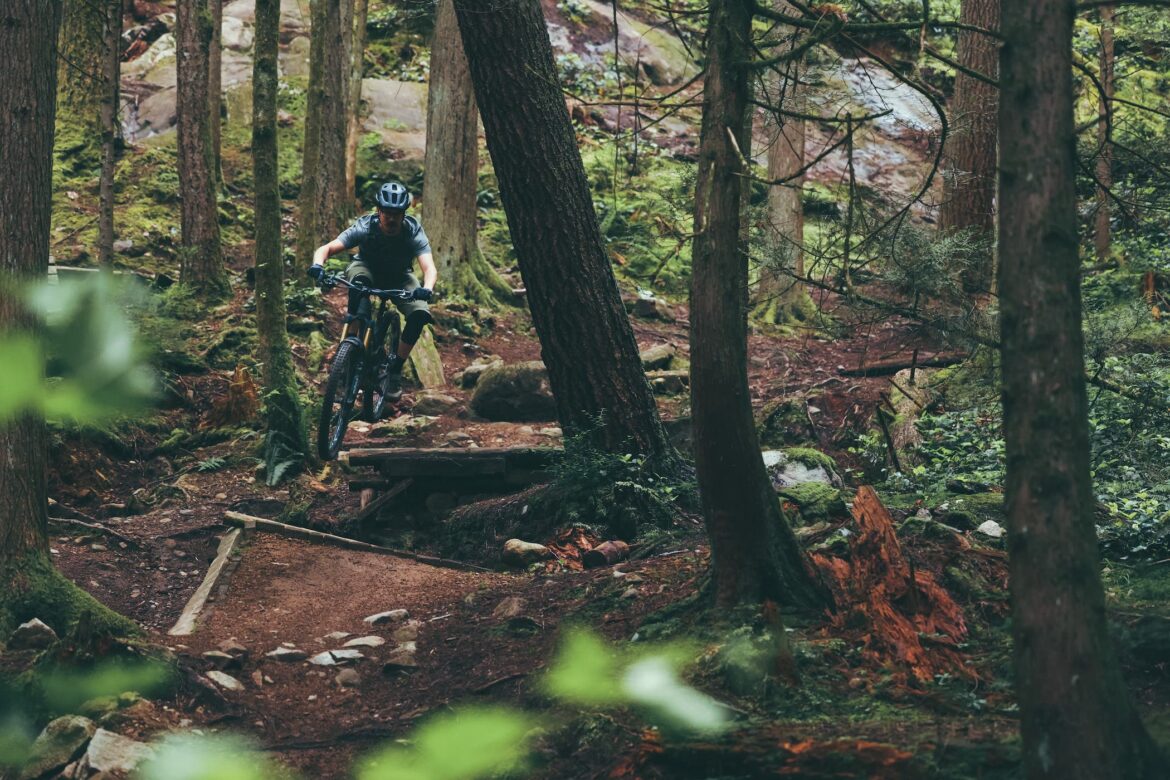
Climbing
The Arrival is a good ascender. We Are One says that they set out to build the best ‘mountain bike’ they could, and climbing comes with that territory. Building a bike that does either climbing or descending well isn’t all that hard, but building a bike that does both well is no easy feat. Thankfully We Are One has managed to make it happen. There are a few different factors at play here, and while the Arrival is a great climber for what it is, it’s not quite perfect.
A big part of what makes this bike climb so well is the weight — the stock build comes in at around 31.5lbs, which is pretty light for a bike of this type. While a little extra weight won’t necessarily translate to a lot of added time on the climbs, many other bikes in this travel bracket are 2-5lb heavier than the Arrival, and that weight is certainly something you can feel on the climb. While the low weight of the Arrival may only result in gains of fractions of a second, it does also give the bike a certain sense of immediacy under uphill acceleration, and on longer fire road and tarmac spins it feels a whole lot more pleasant.
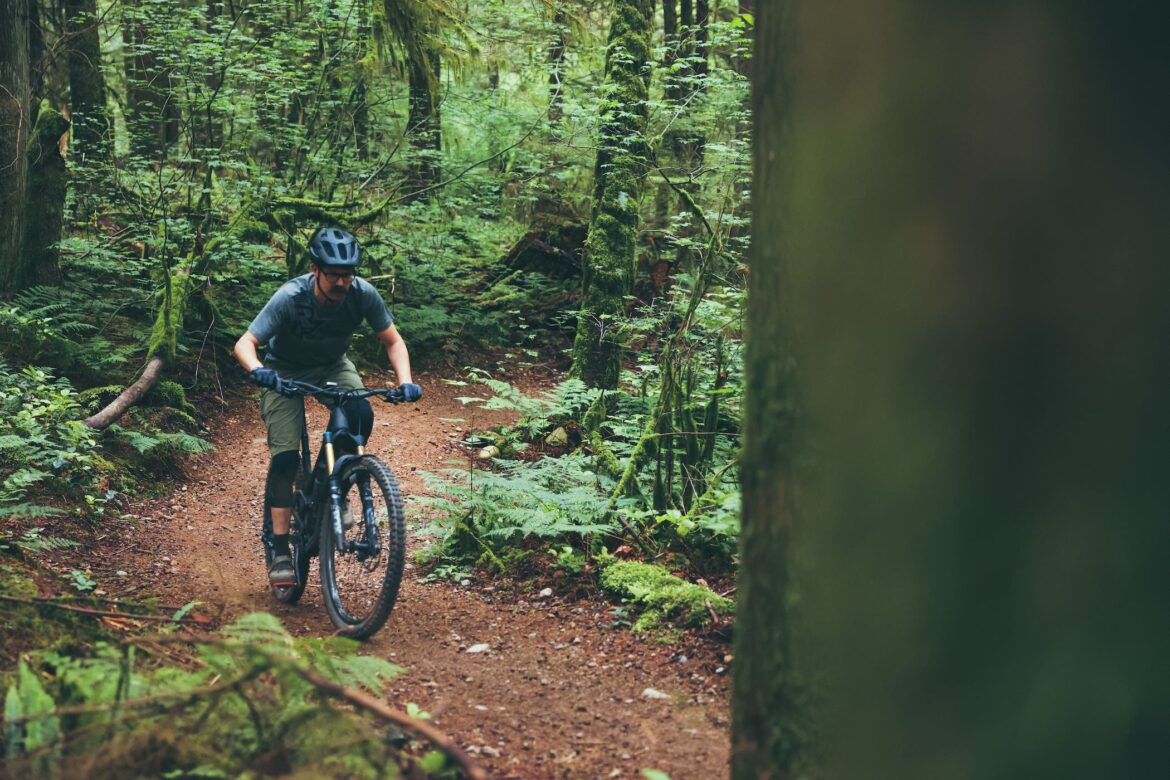
This is all easy to say while ignoring the effects of the bike’s suspension, and getting the air pressure right certainly makes a big difference. We Are One says that the Arrival works best at 22% sag rather than most bikes’ usual 30-35%, and it took some experimentation with air pressures to arrive at something that worked well. (Pun not intended.) At the suggested sag the Arrival still has plenty of give off the top and sits into its travel relatively well with not much in the way of pedal feedback/bob while seated, and has a feeling of ultimate rear wheel traction to the point that it can just crawl over steep rocks and roots without losing traction. However out of the saddle efforts introduce a little more squat than I would have anticipated, and overall made the bike feel like it preferred the sit and spin approach.
When it came to tight corners the length of the bike was a bit of a hindrance. I’m not sure if this is a sizing issue or just the way the bike rides, or both, but tight corners were a bit of a struggle due to the long front end. For the same reason I found the front end prone to lifting/wandering on steep climbs when not fully weighted, and I felt like there are other bikes out there in a similar travel bracket that feel a lot more sprightly and balanced on the way up. But overall for its intention, the Arrival goes uphill pretty damn well.
Descending
The Arrival is a bike that likes to go fast down hill, that much is obvious. It’s clearly been designed with descending in mind, despite what We Are One says about aiming to build the best all-round trail bike, just look at it — it looks fast standing still. Most of us mountain bikers are gravity junkies, and that’s okay to admit.
Running the recommended 22% sag was certainly interesting, and the Arrival feels poppy and firm, but not overly so. There’s definitely a platform that you can really push against at the sag zone and it means that the bike doesn’t feel like it bogs down when things get chunky, but sacrifices a little in small bump sensitivity. It’s not overly harsh but it’s certainly not a magic carpet ride either. That firmness in the back end means that it feels efficient, picks up speed extremely easily, and carries it well down the trail, but it requires a somewhat skilled and confident pilot to push it down the trail.

I’m not claiming to be the most skilled bike rider, in fact some days I feel pretty damn average here in BC, and the Arrival made me acutely aware of it. Thanks to the long reach and the firm feeling at the back, it’s the sort of bike that doesn’t really let you relax a whole lot. The rear wheel feels best when being pushed deep into its travel, and when you can do that the Arrival holds its line really well and isn’t easily deflected, somehow finding grip in lines where it probably shouldn’t, meaning you can push it pretty damn hard. Big compressions, drops to flat, and big rocks did not make the Arrival think twice. I experienced no harsh bottom-out events that I can recall, despite getting the o-ring all the way to the end and running little in the way of compression damping.
The flipside of this is that it’s not terribly easy to just cruise on the Arrival, and if the front wheel isn’t actively weighted it has a tendency to want to lose grip. It was something of a tough bike to live with some days; on the janky North Shore trails it certainly required more than a little body english to muscle it around some tight corners and sketchy features thanks to that long front end.
I will also admit that when I’m having a good day, the Arrival feels amazing. It rewards the rider when they’re pushing hard by supplying grip and smoothing the chunder. I had a couple of really great unexpected results in a local race series on this bike that made me realize just how fast this bike is. The Arrival is definitely the sort of bike that thrives on faster trails, and honestly the nature of the trails on the North Shore means that many bikes can be tricky to set up right since the conditions deliver something of an extreme scenario, so I can forgive it that.
Overall, the Arrival is a fun bike to ride. It pushes the rider to go faster, and on technical trails it can be tricky to ride in a more cautious manner. It can be poppy and playful with a capable rider. It comes more alive the faster it’s going and likes to pretend it’s a bigger bike than it is. It’s a great trail bike for those people that like to push hard every ride but are equally more likely to pedal than shuttle to the top. It would make a great race bike, but may not be the best choice for a less skilled rider or weekend warrior looking for their next trail bike.

We Are One Arrival build and components
I wanted to save the build for last here so that I could talk about what did and didn’t work on the bike while riding it. I feel like it’s unfair on a bike of this price to let an errant component spec affect my or your view of the bike unless it was a major component.
The Arrival is a high-end bike, and comes with a choice of two build kits: expensive or expensiver. There are no aluminum frames, and no budget builds, because that’s not what this bike is about. It’s about not compromising. Having said that, the SP2 bike on test here is the lower end of the two builds, and compared to the current offerings from say Santa Cruz or Specialized it’s surprisingly a fair chunk cheaper, and with arguably some better component spec. Without pedals this build tipped the scales at 31.5lbs – impressively light for a bike with its intentions.

Priced at $8,999 the SP2 build comes with a Factory Fox 36 fork and Float X2 shock with the option to upgrade to a Push Elevensix. You get a full SRAM X01 Eagle drivetrain complete with carbon cranks, Magura MT5 brakes with 203/180mm rotors, We Are One’s in-house Revolution wheels on Industry Nine 1/1 hubs, and their own in house ‘Da Package’ bar and stem combo, a Chris King headset, an SDG Tellis seatpost and seat, and Vittoria Mazza tires.
The Fox Factory suspension performs amazingly, and is well controlled with an amazing range of adjustment. Personally I’ve had a lot of trouble with Float X2 shocks needing rebuilds well before their 125 hour interval, but when they’re working, they work great. I’d love to see an option for a Rockshox build, but I have the same grievance with most brands’ high end builds since I’m a Rockshox guy at heart.

The X01 drivetrain did not skip a beat. Not once. That drivetrain is an amazing workhorse group and I just didn’t need to think about it. I also found the same with the brakes. As a bike mechanic, I’m not a huge fan of Magura brakes, but I only ever see them at their worst, so it was interesting to try a set for real. I wanted to hate them and just couldn’t. They have excellent power and modulation and I basically never wasted time thinking about them. My only complaint is that they’re a little noisy. For me the rotor size was adequate, but I can see people wanting to go bigger on the rear, which could be tricky given the proprietary adapter.
We Are One built their reputation on their wheels, and rightly so. Their Revolution hoops held up to a good amount of abuse and the I9 1/1 hubs are something I’ve been using for a year or so now on various bikes and love, so good choice there. The tire spec is my major complaint here; I blew out the rear Vittoria Mazza on the second or third ride, and pulling it off, the casing was equivalent to probably an EXO Maxxis casing, that is, very thin. I get that tire choice is pretty personal, but on a bike that’s made to be relatively burly, I’d expect something a little tougher. Adding to this, the compound on the tires is quite firm and again I get that it probably works for someone somewhere, but for a BC brand I’d have expected something with a little more grip.
The Mazza tires didn’t give me the confidence I wanted in the bike and overall they were not super predictable. I replaced the rear tire with a Continental Kryptotal with the DH casing and soft compound and suddenly the back end of the bike felt like it was tracking like it should with confidence. Thanks to the thin tire casings I bottomed out on the rims both front and rear several times, but the rims held up with no damage that I could see. My personal preference is that I’d want to see a heavier casing, and I run CushCore in all of my bikes, because the trails on the North Shore are especially unforgiving.
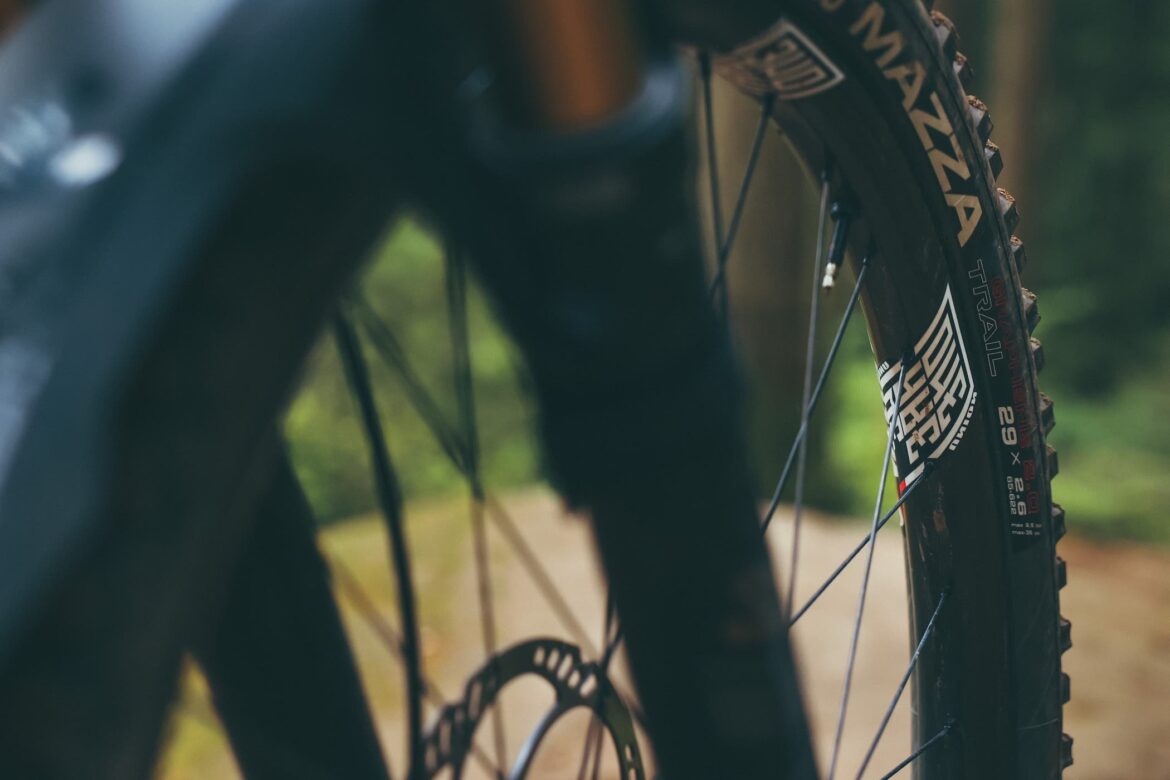
The bars and stem are also from We Are One. The carbon bar is hand-laid in Kamloops and the stem is machined in house, and both are truly things of beauty. They are unassuming to look at yet clearly with a really high finish quality. I appreciate the inclusion of these on the bike, again at what I would call a reasonable price point considering the place of manufacturing. It’s tough to comment on how the bar felt in terms of vibration damping given that I didn’t have time to test it against anything else, but it felt comfy enough with pretty standard 800mm wide, 5º up-sweep, and 8º back-sweep bars.
Lastly the SDG finishing kit is decent enough. The bike is obviously built to a price and if the seatpost is the only ‘not amazing’ component on the bike bar the tires, I’m okay with that. It’s a cartridge type post and it worked flawlessly, if not amazingly. My bum didn’t get on with the Bel Air V3 saddle, and my hands found the grips a little too firm/thin, but these are minor complaints, and I always find that the touch points are very personal anyway.



To upgrade to the SP1 spec costs an extra $1,756 for a total price of $10,755. That pays for an upgrade to I9’s top end Hydra hubs, X01 AXS wireless drivetrain and an AXS Reverb dropper post, and Magura’s higher end MT7 brakes. Personally I was perfectly happy with the spec on this bike, but if wireless shifting is your jam then eat your heart out.
I’ll finish this section up by saying that apart from the rear tire, nothing broke while I was testing this bike. No loose pivot bolts, nothing. I had to pay very little attention to the Arrival mechanically, which was really nice.
We Are One backstory
Founded by ex-pro downhill racer Dustin Adams in Kamloops BC, We Are One is the first and only company manufacturing bike rims in-house in Canada. Dustin built the business from scratch, officially launching in 2017, aiming to produce a bike frame within five years. Lofty dreams for sure, but the company did it, and here it is.
The Arrival is not only the first frame that We Are One has produced, and not only is it possibly the first mass-manufactured Canadian carbon frame, but it might also be one of the most ethically-produced carbon frames around. That’s not to say that it’s any more recyclable than any other carbon, but the brand is committed to repairing rather than replacing broken frames, even though they know it’s more labor intensive. This way the frames stay out of the garbage in the first place.



We Are One is dedicated to supporting Canadian manufacturing, claiming 99% of the raw materials used for the Arrival frame coming from within a 500 mile radius of the brand’s facility in BC.
The Arrival is designed to be a “complete mountain bike” for many different types of riding. That means a conventional floating pivot suspension system, rather than a high pivot/idler setup as is trendy right now — and that’s no bad thing. We Are One has put a focus on creating something of high quality with predictable performance using a manufacturing process they can closely monitor to control the quality of the end product.



We Are One says that the Arrival is designed to be both a strong climber and descender and to come in at a weight that makes it competitive in whatever you want to do with it. To this end, the brand decided to use a floating pivot suspension design because they wanted to make the bike super supple and active, great for rough and choppy terrain, yet with the ability to tune the leverage curve to give the rider a platform right at the sag point for efficient pedaling. It’s worth noting that the Arrival is designed to be run at around 22-25% sag, which is around 10% less than most conventional full suspension bikes.
We Are One Arrival geometry
| SZ1 | SZ2 | SZ3 | |
| Recommended Rider Height | 5’3″ – 5’8″ | 5’8″- 5’11” | 5’11 – 6’4″ |
| Reach | 450mm | 475mm | 500mm |
| Stem length | 45mm | 45mm | 45mm |
| Stack | 616mm | 621mm | 626mm |
| Headtube length | 95mm | 100mm | 105mm |
| Chainstay Length | 437mm | 437mm | 441mm |
| Headtube Angle | 64° | 64° | 64° |
| Front Center | 783mm | 809mm | 836mm |
| Wheelbase | 1220mm | 1246mm | 1277mm |
| Seat tube angle – 77deg | 77° | 77° | 77° |
| BB drop | 37mm | 37mm | 37mm |
| BB height | 338mm | 338mm | 338mm |
| Effective top tube length | 593mm | 610mm | 645.5mm |
| Fork offset | 44mm | 44mm | 44mm |
| Dropper length | 150mm | 150/170mm | 170/200mm |
| Standover | 665mm | 665mm | 676mm |
The Arrival comes in three sizes and geometry is decidedly modern. On test here is the SZ3 designed for riders 5’11” to 6’4″ and with a 500mm reach and a 441mm chainstay. It’s definitely on the lengthy side of things and sits probably somewhere between a modern large and extra large. With low standover heights, not excessively long head tubes, and the option to choose different dropper post lengths and bar rise, it means that while sizing options might be limited, riders can tune their fit in better than with a lot of other bikes.

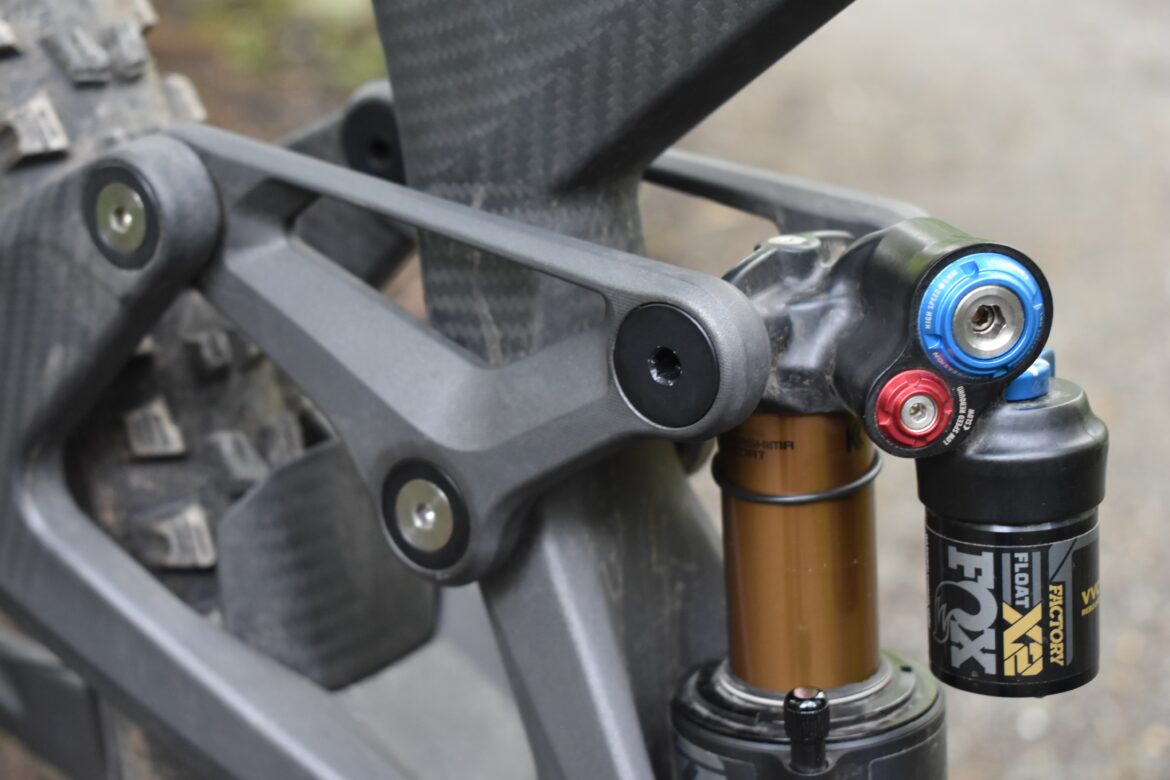

In terms of head angle, we’re looking at a slack 64° coupled with a 77° seat tube angle to move the riders weight forward for climbing. We Are One says they wanted the Arrival to have the ‘in the bike’ rather than ‘on the bike’ ride feel, and to achieve this they’ve dropped the bottom bracket by up to 20mm over other bikes in this category; with a 37mm BB drop, the Arrival is low for sure.

Pros and cons of the We Are One Arrival
Pros
- Incredibly fast descender
- Efficient climber
- Amazing build quality
Cons
- Sizing a little off the mark
- Poor tire spec
- Doesn’t work at anything less than full bore
Final thoughts
The We Are One Arrival is a tough bike to categorize, and as I mentioned before, it’s probably best described as a shorter travel bike pretending to be a big bike. It took me a while to get used to it and get it set up properly, and I could probably still take some time to dial the shock settings in a little better. I really like how well the Arrival handles at speed. It’s a bike that suits fast trails and fast riders, and that’s when it really comes alive. Its slow speed handling left a little to be desired, but I’m aware that there aren’t many places in the world like the North Shore.
I also really enjoyed the combination of shorter travel with aggressive geometry on the Arrival, not that 150mm is particularly short, but the geometry is more befitting of something like the Knolly Chilcotin, which honestly I found to be quite a brutish and sluggish bike to ride at times. The Arrival still feels nimble and lively yet pinner fast. I like it, and on my good days it made me feel really good. It’s not quite what I’d call an enduro bike these days because of the travel bracket, but maybe it is because it’s just so fast, and for the same reason I’m not quite sure I’d call it a trail bike. It climbs amazingly well for an enduro bike, and averagely for a trail bike. So what even is it?
I’ll wrap things up by saying that the Arrival is quite clearly a very high-end and niche bike. It’s probably not something I’d recommend to the average trail rider since it really needs a skilled pilot to unlock its full potential, and I just barely make the cut. If you’re looking for an enduro race weapon with a little extra versatility and pedal-ability with a high-end build spec from a niche brand and with good factory support, this could be it. My one recommendation is that if you can’t test ride one, take a good long look at the geometry charts.



Editor’s note: Updated with additional information from We Are One regarding the leverage curve, and corrected the seat post diameter.





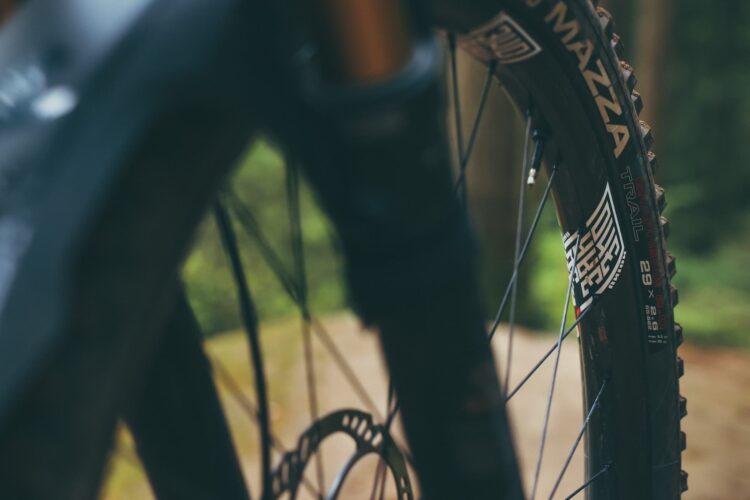
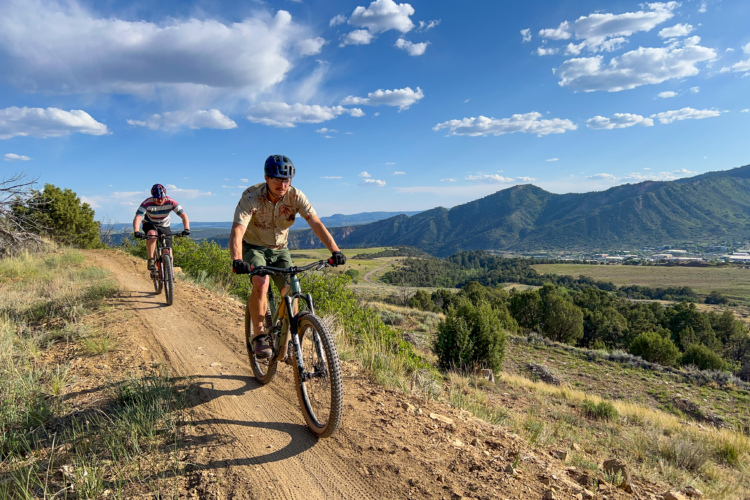


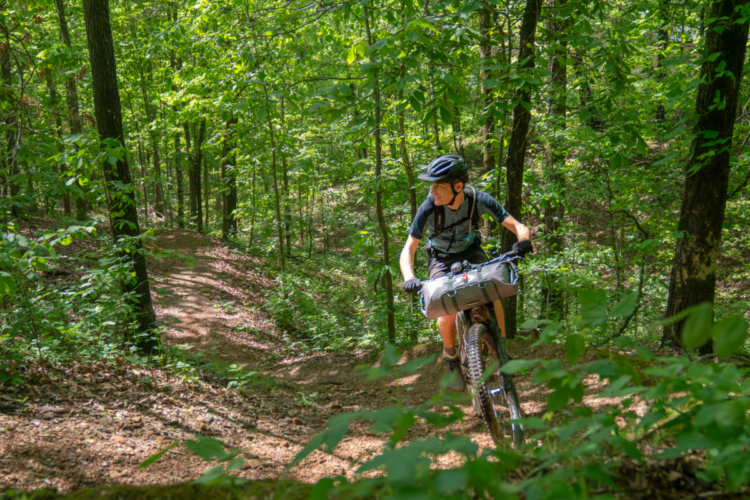

9 Comments
Jul 29, 2022
I love the story behind We Are One and the fact that it's 99% made in North America.
I'd be curious how this bike compares to other 150mm Enduro bikes like the Ripmo, SB150, Sentinel or the Wreckoning(I know this on is more travel, but it gets a lot of the same praise- poppy playful efficient)
Thank you!
Aug 17, 2022
That said I’m two rides in on the Ibis so take that with a pinch of salt.
Nov 23, 2022
Nov 23, 2022
As far as the best bike for all-around BC riding, again it's tough. The Arrival feels like a flat-out race machine and is absolutely capable of pretty well anything, but it really does work you to extract that speed. That's not to say it can't be fun, but the Ripmo definitely has a more laid back sort of feel to it with slightly less aggressive geometry and more 'grip and rip' kind of feel to it rather than the edge of your seat kind of feel on the Arrival. (was I chatting with you about this in the shop recently?)
I think personally I'd choose the Arrival, but it's hard not to want the $10k bike more than the $5k bike, right?
Nov 23, 2022
Feb 1, 2023
Feb 2, 2023
Never ridden a Druid I'm afraid, or any other high pivot bike for that matter, hoping to change that at some point.
Jul 4, 2022
The Mazza Trail is a good trail tire, but for harder riding it's well worth going up to the Enduro casing. They probably wanted to save that .5lbs on the spec sheet.
I think on a bike this expensive, any component issues are worth mentioning and fair game. It would also be different if they offered a frame onely option, but since you have to pick one of their builds those builds had better be totally dialed. Having to replace parts that quickly kind of damages their goal, and marketing pitch, of being environmentally focused. Still way better than most brands but I think that having to swap out parts from a base build is wasteful.
Jul 4, 2022
I'm in agreement with you for the most part and I do think you're right about them trying to save some grams on their spec sheet, however I also acknowledge that tire choice is incredibly personal and highly dependent on area. That said if they had specced EXO+ or DD Maxxis tires (say a Minion/Assegai) I can't see many people swapping them out before they're worn out. So in that case I do agree.